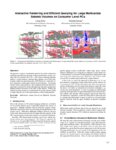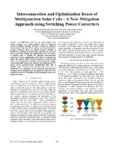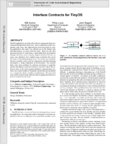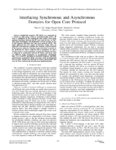|
|
Creator | Title | Description | Subject | Date |
| 1051 |
 | Wan, Yong | Interactive extraction of neural structures with user-guided morphological diffusion | Extracting neural structures with their fine details fromconfocal volumes is essential to quantitative analysis in neurobiology research. Despite the abundance of various segmentation methods and tools, for complex neural structures, both manual and semi-automatic methods are ineffective either in f... | | 2012-01-01 |
| 1052 |
 | Hansen, Charles D.; Wald, Ingo | Interactive isosurface ray tracing of large octree volumes | We present a technique for ray tracing isosurfaces of large compressed structured volumes. Data is first converted into a losslesscompression octree representation that occupies a fraction of the original memory footprint. An isosurface is then dynamically rendered by tracing rays through a min/max... | | 2006-09 |
| 1053 |
 | Hansen, Charles D.; Wald, Ingo | Interactive isosurface ray tracing of time-varying tetrahedral volumes | Abstract- We describe a system for interactively rendering isosurfaces of tetrahedral finite-element scalar fields using coherent ray tracing techniques on the CPU. By employing state-of-the art methods in polygonal ray tracing, namely aggressive packet/frustum traversal of a bounding volume hierarc... | | 2007-11 |
| 1054 |
 | Parker, Steven G.; Johnson, Christopher R. | Interactive manipulation of contour data using the layers program | The "layers" program is useful for visualizing and editing large sets of contour data. These datasets arise frequently when trying to extract geometry from MRI slices. Due to the imprecise nature of the MR imaging and segmentation processes, the contours extracted may not accurately reflect the huma... | Contour data; Layers program; MRI slices | 1994 |
| 1055 |
 | Parker, Steven G.; Hansen, Charles D.; Shirley, Peter S. | Interactive ray tracing for volume visualization | We present a brute-force ray tracing system for interactive volume visualization, The system runs on a conventional (distributed) shared-memory multiprocessor machine. For each pixel we trace a ray through a volume to compute the color for that pixel. Although this method has high intrinsic computa... | Ray tracing; Volume visualization; Isosurfaces; Maximum-intensity projection; Traversal optimizations | 1999 |
| 1056 |
 | Hansen, Charles D.; Wald, Ingo | Interactive ray tracing of arbitrary implicits with SIMD interval arithmetic | We present a practical and efficient algorithm for interactively ray tracing arbitrary implicit surfaces. We use interval arithmetic (IA) both for robust root computation and guaranteed detection of topological features. In conjunction with ray tracing, this allows for rendering literally any progr... | | 2007-09 |
| 1057 |
 | Wyman, Chris; Hansen, Charles D.; Shirley, Peter S. | Interactive raytraced caustics | In computer graphics, bright patterns of light focused onto matte surfaces are called ?caustics?. We present a method for rendering dynamic scenes with moving caustics at interactive rates. This technique requires some simplifying assumptions about caustic behavior allowing us to consider it a lo... | Raytraced caustics | 2003-04-23 |
| 1058 |
 | Hansen, Charles D. | Interactive rendering and efficient querying for large multivariate seismic volumes on consumer level PCs | We present a volume visualization method that allows interactive rendering and efficient querying of large multivariate seismic volume data on consumer level PCs. The volume rendering pipeline utilizes a virtual memory structure that supports out-of-core mul- tivariate multi-resolution data and a GP... | | 2013-01-01 |
| 1059 |
 | Johnson, Christopher R.; Parker, Steven G.; Hansen, Charles D. | Interactive simulation and visualization | Most of us perform data analysis and visualization only after everything else is finished, which often means that we don't discover errors invalidating the results of our simulation until postprocessing. A better approach would be to improve the integration of simulation and visualization into the... | Computational steering; Interactive simulation; Isosurfaces | 1999 |
| 1060 |
 | Hansen, Charles D. | Interactive texture-based volume rendering for large data sets | Visualization is an integral part of scientific computation and simulation. State-of-the-art simulations of physical systems can generate terabytes to petabytes of time-varying data where a single time step can contain more than a gigabyte of data per variable. As memory sizes continue to increase, ... | Parallel rendering; Volume rendering; TRex | 2001 |
| 1061 |
 | Hansen, Charles D. | Interactive translucent volume rendering and procedural modeling | Direct volume rendering is a commonly used technique in visualization applications. Many of these applications require sophisticated shading models to capture subtle lighting effects and characteristics of volume metric data and materials. Many common objects and natural phenomena exhibit visual qua... | Volume rendering; Volume visualization; Direct volume rendering; Multidimensional transfer functions; Direct manipulation widgets; Graphics hardware | 2002 |
| 1062 |
 | Hansen, Charles D.; Chien, Chi-Bin | Interactive visualization tool for multi-channel confocal microscopy data in neurobiology research | Confocal microscopy is widely used in neurobiology for studying the three-dimensional structure of the nervous system. Confocal image data are often multi-channel, with each channel resulting from a different fluorescent dye or fluorescent protein; one channel may have dense data, while another has ... | Volume rendering; Zebrafish | 2009-11 |
| 1063 |
 | Parker, Steven G.; Hansen, Charles D. | Interactive volume rendering of large datasets using the silicon graphics Onyx4 visualization system | Many recent approaches to interactive volume rendering have focused on leveraging the power of commodity graphics hardware. Though currently limited to relatively small datasets, these approaches have been overwhelmingly successful. As the size of volumetric datasets continues to grow at a rapid pa... | Volume visualization; Onyx4; Interactive volume rendering; Parallel volume rendering; Large datasets; Visualization systems | 2005 |
| 1064 |
 | Parker, Steven G.; Hansen, Charles D. | Interactive volume rendering of large datasets using the silicon graphics Onyx4 visualization system | Many recent approaches to interactive volume rendering have focused on leveraging the power of commodity graphics hardware. Though currently limited to relatively small datasets, these approaches have been overwhelmingly successful. As the size of volumetric datasets continues to grow at a rapid ... | Interactive volume; Rendering; Large datasets; Onyx4; Silicon graphics | 2004-01-27 |
| 1065 |
 | Hansen, Charles D. | Interactive volume rendering using multi-dimensional transfer functions and direct manipulation widgets | Most direct volume renderings produced today employ one-dimensional transfer functions, which assign color and opacity to the volume based solely on the single scalar quantity which comprises the dataset. Though they have not received widespread attention, multi-dimensional transfer functions are a ... | Volume rendering; Volume visualization; Direct volume rendering; Multidimensional transfer functions; Direct manipulation widgets; Graphics hardware | 2001 |
| 1066 |
 | Hansen, Charles D. | Interactive volume rendering using multi-dimensional transfer functions and direct manipulation widgets | Most direct volume renderings produced today employ onedimensional transfer functions, which assign color and opacity to the volume based solely on the single scalar quantity which comprises the dataset. Though they have not received widespread attention, multi-dimensional transfer functions are a v... | Volume rendering; Volume visualization; Direct volume rendering; Multidimensional transfer functions; Direct manipulation widgets; Graphics hardware | 2001 |
| 1067 |
 | Lefohn, Aaron; Cates, Joshua E.; Whitaker, Ross T. | Interactive, GPU-based level sets for 3D brain tumor segmentation | While level sets have demonstrated a great potential for 3D medical image seg- mentation, their usefulness has been limited by two problems. First, 3D level sets are relatively slow to compute. Second, their formulation usually entails several free parameters which can be very difficult to correc... | Level sets; Medical imaging; 3D brain tumor segmentation | 2003-04-16 |
| 1068 |
 | Balasubramonian, Rajeev | Interconnect-aware coherence protocols for chip multiprocessors | Improvements in semiconductor technology have made it possible to include multiple processor cores on a single die. Chip Multi-Processors (CMP) are an attractive choice for future billion transistor architectures due to their low design complexity, high clock frequency, and high throughput. In a... | Interconnects; Chip multiprocessors; Coherence | 2006 |
| 1069 |
 | Khan, Faisal Habib | Interconnection and optimization issues of multijunction solar cells - A new mitigation approach using switching power converters | A multijunction solar cell can extract higher solar energy compared to a single junction solar cell using the spectrum splitting technique. Extensive research on efficiency enhancement of the solar cells to achieve near theoretical limit is in place. However, there are limited research activities to... | | 2012-01-01 |
| 1070 |
 | Hibler, Michael J. | Interface and execution models in the fluke kernel | We have defined and implemented a new kernel API that makes every exported operation either fully interruptible and restartable, thereby appearing atomic to the user. To achieve interruptibility, all possible states in which a thread may become blocked for a "long" time are completely representable ... | Fluke kernel; Interruptibility | 1998 |
| 1071 |
 | Regehr, John | Interface contracts for TinyOS | TinyOS applications are built with software components that communicate through narrow interfaces. Since components enable fine-grained code reuse, this approach has been successful in creating applications that make very efficient use of the limited code and data memory on sensor network nodes. How... | | 2007-01-01 |
| 1072 |
 | Christensen, Douglas A. | Interface of forest and agriculture in nonpoint pollution control | Management practices of agriculture, including conservation and tillage options, recently have received a great deal of attention with respect to their impact upon the environment. Research efforts have focused both on the direct impacts of reduced on-site productivity resulting from the erosion of ... | Suspended sediment; Channel erosion; Silviculture | 1983 |
| 1073 |
 | Stevens, Kenneth | Interfacing synchronous and asynchronous domains for open core protocol | Intellectual property (IP) blocks are connected in a system on chip using a bus or network-on-chip (NoC). IP reuse is facilitated by the modularity that results when using common interfaces between the IP cores and the bus or NoC. This paper investigates and implements several versions of one of the... | | 2014-01-01 |
| 1074 |
 | Myers, Chris J. | Interfacing synchronous and asynchronous modules within a high-speed pipeline | Abstract-This paper describes a new technique for integrating asynchronous modules within a high-speed synchronous pipeline. Our design eliminates potential metastability problems by using a clock generated by a stoppable ring oscillator, which is capable of driving the large clock load found in pre... | | 2000 |
| 1075 |
 | Myers, Chris J. | Interfacing synchronous and asynchronous modules within a high-speed pipeline* | This paper describes a new technique for integrating asynchronous modules within CI high-speed synchronous pipeline. Our design eliminates potential metastability problems by using Q clock generated by Q stoppable rang oscillator, which is capable of driving the large clock load found in present d... | | 1997 |

























